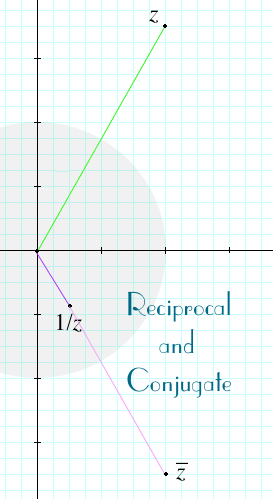
Now, if two complex numbers are equal, then their real parts have to be equal and their imaginary parts have to be equal. In order that zw = 1, we'll need
That gives us two equations. The first says the real parts are equal:
and the imaginary parts are equal:
Now, in our case, z was given and w was unknown, so in these two equations x and y are given, and u and v are the unknowns to solve for. You can fairly easily solve for u and v in this pair of simultaneous linear equations. When you do, you'll find
| u = | x x2 + y2 |
and v = | –y x2 + y2 |
. |
So, the reciprocal of z = x + yi is the number w = u + vi where u and v have the values just found. In summary, we have the following reciprocation formula:
| 1 x + yi |
= | x x2 + y2 |
+ | –y x2 + y2 |
i. |
Reciprocals done geometrically, and complex conjugates. From what we know about the geometry of multiplication, we can determine
 reciprocals geometrically. If z and w are reciprocals, then zw = 1, so the product of their absolute values is 1, and the sum of their arguments (angles) is 0.
reciprocals geometrically. If z and w are reciprocals, then zw = 1, so the product of their absolute values is 1, and the sum of their arguments (angles) is 0.
This means the length of 1/z is the reciprocal of the length of z. For example, if |z| = 2, as in the diagram, then |1/z| = 1/2. It also means the argument for 1/z is the negation of that for z. In the diagram, arg(z) is about 65° while arg(1/z) is about –65°.
You can see in the diagram another point labelled with a bar over z. That is called the complex conjugate of z. It has the same real component x, but the imaginary component is negated. Complex conjugation negates the imaginary component, so as a transformation of the plane C all points are reflected in the real axis (that is, points above and below the real axis are exchanged). Of course, points on the real axis don't change because the complex conjugate of a real number is itself.
Complex conjugates give us another way to interpret reciprocals. You can easily check that a complex number z = x + yi times its conjugate x – yi is the square of its absolute value |z|2.
| z | z |
= |z|2 |
Therefore, 1/z is the conjugate of z divided by the square of its absolute value |z|2.
| 1/z = | z |
/ |z|2 |
In the figure, you can see that 1/|z| and the conjugate of z lie on the same ray from 0, but 1/|z| is only one-fourth the length of the conjugate of z (and |z|2 is 4).
Incidentally, complex conjugation is an amazingly "transparent" operation. It commutes with all the arithmetic operations: the conjugate of the sum, difference, product, or quotient is the sum, difference, product, or quotient, respectively, of the conjugates. Such an operation is called a field isomorphism.
Division. Putting together our information about products and reciprocals, we can find formulas for the quotient of one complex number divided by another. First, we have a strictly algebraic formula in terms of real and imaginary parts.
| x + yi
u + vi |
= | (xu + yv) + (–xv + yu)i
u2 + v2 |
Next, we have an expression in complex variables that uses complex conjugation and division by a real number.
| z/w = z | w |
/ |w|2 |
Both formulations are useful and well worth knowing and understanding.
Next section: Powers and roots
Previous section: Angles and polar coordinates
 © 1999.
© 1999.
David E. Joyce
Department of Mathematics and Computer Science
Clark University
Worcester, MA 01610
Email: djoyce@clarku.edu
These pages are located at http://www.clarku.edu/~djoyce/complex/